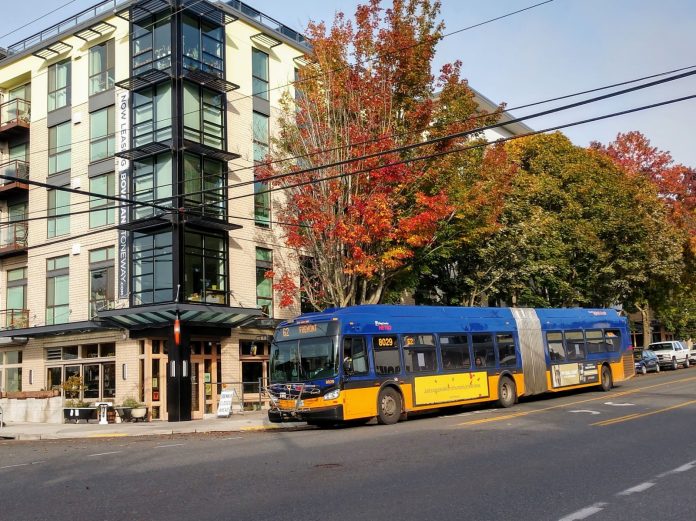
King County Metro unveiled its initial Northgate Bus-to-Link restructure proposal yesterday at a press briefing at King Street Center. The emphasis is on additional crosstown bus service to bring transit riders to the three new North Seattle light rail stations opening in 2021 with the Northgate Link extension. Several major revisions of routes are proposed with subsequent route renamings. Crosstown service would improve on NW/N 85th Street, NE 75th Street, NE 65th Street, and NE Northgate Way.
“Metro and Sound Transit are working to finalize an integrated, customer-centered transit network of over 30 bus routes that connect with fast, reliable Link light rail–all with a focus on improving access to opportunities for historically underserved residents,” Metro spokesperson Jeff Switzer said in a statement.
The proposal builds off the successful U Link restructure which greatly expanded frequent transit coverage in Northeast Seattle following the University Link extension in 2016. The idea is similar here, with routes bending to feed the light rail stations in order to give riders more options for local connections. (You can review the route proposals and take a survey—in the region’s six most widely-spoken languages—at Metro’s Northgate Link Connections website.) Metro has gathered feedback online and via its community-based Mobility Board to guide route decisions. Two Mobility Board members attended the presser and commended Metro for its progress and engagement.
Fremont and lower Wallingford snubbed?
Overall, Metro’s restructure proposal is intriguing and promising, but the southern halves of Fremont and Wallingford don’t benefit as much from this proposal as some neighborhoods. The new Route 16 (replacing Route 5X but not Route 5 Local) would absorb most of the new hours and Route 26 would disappear in favor of the peak-only Route 25. By the way, Metro said not to get too attached to the names which are mainly placeholders at this point–Route 16 could be confusing for folks who remember Metro’s old route on Latona Avenue by the same name.
Routes 31 and 32 continue to be the only direct connection to the east, where University of Washington and a second light rail station are big draws. The new Route 23 marginally boosts U District access, but not for the southern portion of Wallingford or for Fremont.
Catching a 62 and switching to a 44 or 23 to reach the U District is another option for people who live closer to the canal than N 45th Street, but from a user standpoint I wouldn’t recommend it unless increased frequency really does wonders. Moreover, since Route 44’s promised RapidRide upgrades are sitting in limbo, it’s not clear when the corridor’s transit speed and reliability will improve. Adding bus lanes–as the Move All Seattle Sustainably (MASS) coalition has urged–would help, but Bill Bryant, Metro’s Director of Service Development, said no N 45th Street bus lane plans are in the works yet.
All in all, the proposal ends up feeling a bit half-baked for Fremont and Wallingford, which are not in Sound Transit’s light rail plans and thus dependent on bus service. Having express routes bypassing the areas comes with the trade-off that service within Fremont and Wallingford will likely be a bit light.
Here’s a quick rundown of proposed Northgate Bus-to-Link changes.
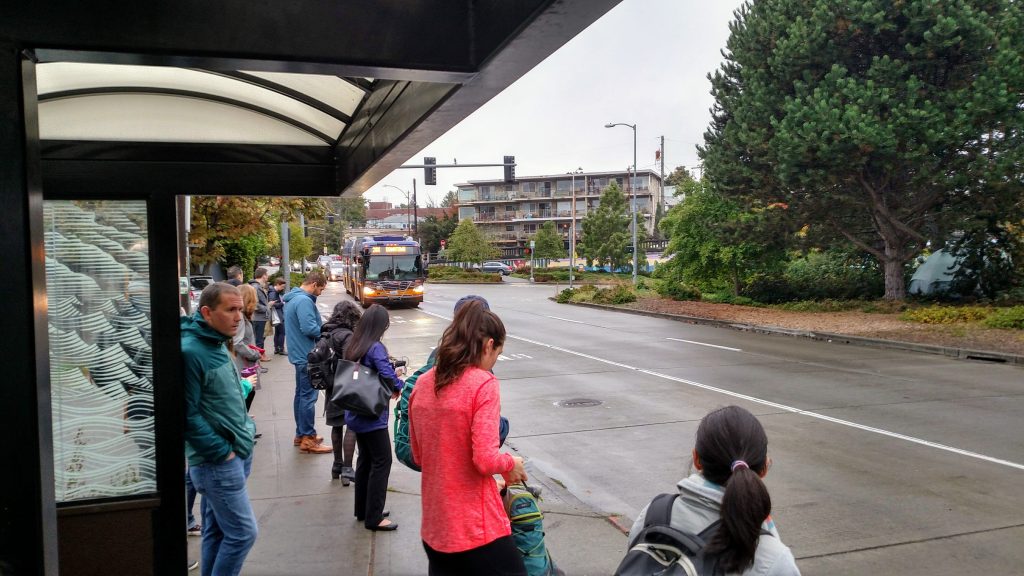
- New Route 61 connects NW/N 85th Street corridor to Northgate and Lake City, replacing the westernmost section of Route 45, with 12-minute headways at peak and 15-minute headways until 10pm.
- Route 45 now terminates in Greenwood at N 85th Street and Greenwood Avenue N. Service will be rerouted via N 80th Street and through Green Lake’s urban core rather than along the park with 12-minute headways at peak and 15-minute headways until 10pm.
- Route 41 phased out, with Lake City riders directed toward light rail.
- New Route 79 provides crosstown service on NE 75th Street, connecting Roosevelt Station to Magnuson Park.
- New Route 68 provide express service to South Lake Union and Uptown from Northgate Station. The route uses Harrison Street and then Mercer Street west of 5th Avenue N.
- Route 5X becomes the shorter Route 16, terminating in Bitter Lake and using Aurora Avenue N at N 46th Street. Route 16 would top out at 11-minute frequency.
- Route 5 (local) stays in its currently routing but no boost in service levels.
- Route 44 gets 10-minute frequency all day. And from 8pm to 1am it will come every 17 minutes. The eastbound bus would turn south at 12th Avenue NE to pass closer to U District Station via NE 43rd Street. The westbound version doesn’t do this, staying on its existing routing.
- Route 62 turns east sooner on N 55th Street heading north to N 65th Street via Latona Avenue N instead of Meridian Avenue N. It also gets a frequency boosts topping out at every eight minutes during afternoon peak.
- New Route 25 replaces much of Route 26 and the rerouted portion of Route 62, with a route revision in Green Lake and through central Wallingford. Metro proposes a peak-only route at 18-minute headways with no weekend service.
- New Route 23 acts as a circulator from Husky Station to Roosvelt Station linking Green Lake, Wallingford and the U District and mirroring a section of Route 26.
- Metro is sticking with Route 31/32 couplet to give Lower Fremont and Lower Wallingford access to light rail and University of Washington campus, with a deviation to use NE 43rd Street to provider a better connection to U District Station and NE 45th Street to provide a faster path to U Village than Stevens Way. Theoretically, the 31 and 32 add up to a frequent route where they overlap in North Seattle, but in practice it doesn’t feel frequent. The minimal changes here leaves the question hanging: will it be enough?
- Route 40 takes a more direct path to Northgate Station rather than passing right by North Seattle College, which will have a new pedestrian bridge over I-5 to access Northgate Station.
- Routes 301, 302, 303, 304, 345, 346, 347, 348 all feed Northgate Station from the north via different routings. Route 302 and 303 also continue to Downtown Seattle via I-5.
- Routes 312 and 522 would feed Roosevelt Station and the suburban corridor along SR-522–perhaps keeping the route warm for Sound Transit’s 522 bus rapid transit line that opens in 2024. Route 309 will continue to provide express service to South Lake Union, Downtown Seattle, and First Hill via SR-522 and I-5.
- Most other Northeast Seattle routes stay pretty much the same with some consolidation–Routes like the 372, 75 and 65 north of the Ship Canal. However, Route 75 will be routed to U District Station via NE 45th Street and peak-hour versions of the 70 series will no longer serve Downtown Seattle with express service. Route 77, for instance, will be discontinued and reinvested into local service for the series. The 70 series (Routes 70, 73, and 74) mostly doesn’t deviate directly to U District Station in this proposal, staying on University Way NE (The Ave) instead, but will for serving Roosevelt Station.
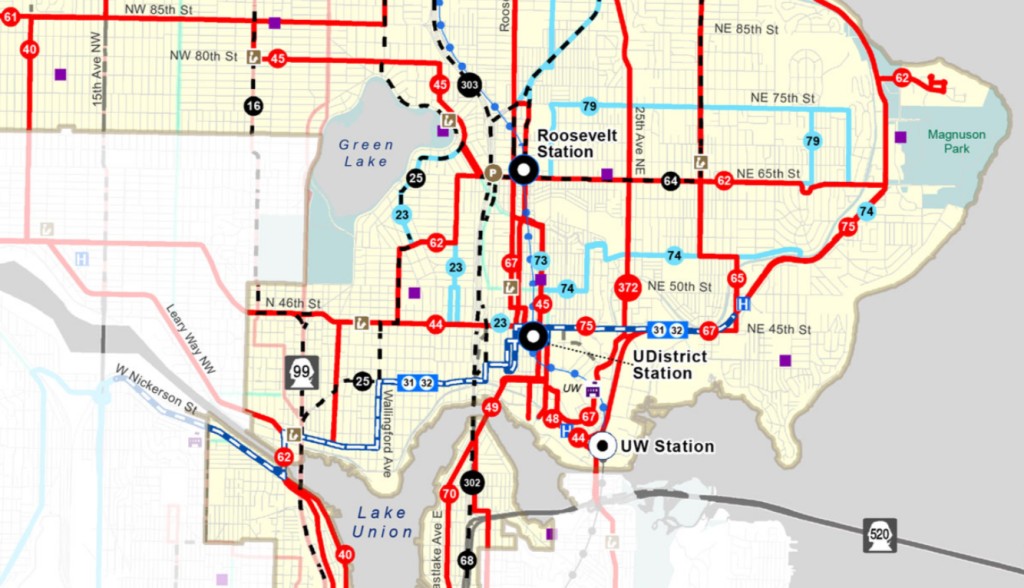
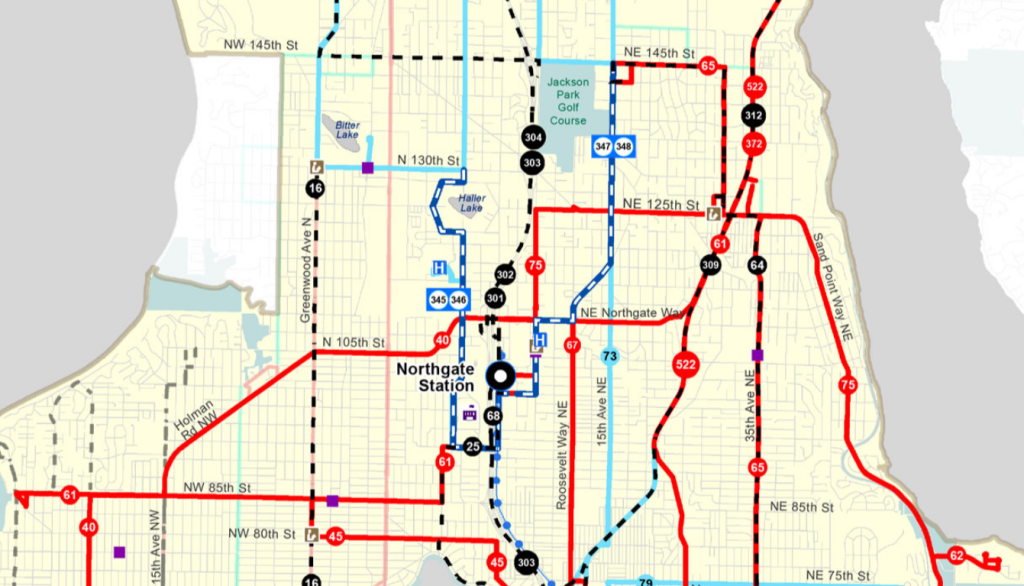
Route 61: Crosstown from Lake City to Loyal Heights
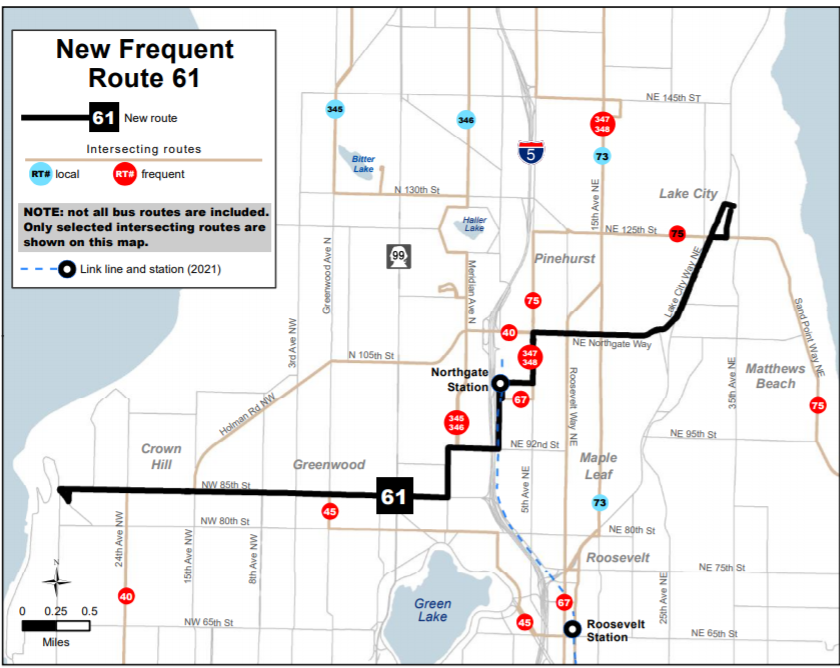
Route 61 would join the frequent transit network in Metro’s proposal, and provide a unique crosstown option from Loyal Heights to Lake City, stopping by Northgate Station on the way. A portion of this route would take over for Route 45 on NW 85th Street, since Route 45 will terminate in Greenwood under the proposal.
There appears to be a good bit of stop consolidation with a stop at N 46th St and Phinney Ave being Fremont’s only stop.
Route 16 Expands Route 5X
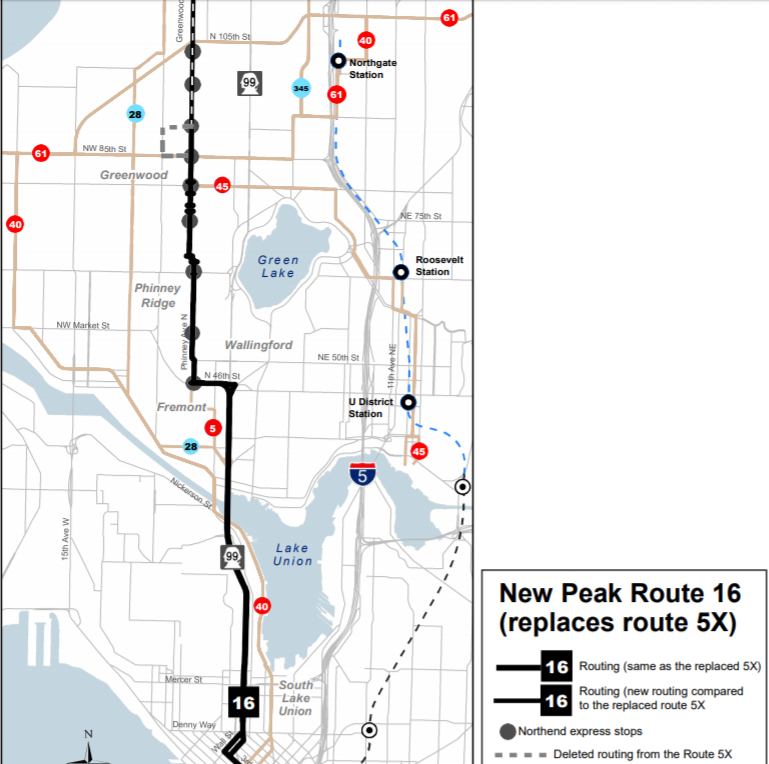
Route 5 is one of Metro’s workhorse routes, but can also be plagued by delays. Metro seems to be taking a stab at addressing that. Unfortunately, the solution seems to be to focus attention on express service bypassing Fremont (and extending the route farther to the north in Bitter Lake). With RapidRide E Line already bypassing Fremont, the decision could mean a shortage of service in Fremont and Wallingford, which are both growing rapidly.
Adding an Aurora Bus Stop at N 38th Street
One way to rectify that would be to add a Lower Fremont bus stop at Aurora Avenue and N 38th Street, as I and others have proposed, but that’s not indicated in Metro’s proposal. Metro appears to be planning 11-minute headways for Route 16. Route 28 and the new Route 25 do not manage anywhere near that, and many riders prefer to avoid Route 40 and Route 62 at peak times since both run headlong into Mercer Mess traffic, making them slow and unreliable.
Without a fix for Fremont and Wallingford, Metro’s otherwise promising proposal leaves a lot to be desired. The other looming question is funding. If the Washington State Supreme Court upholds Initiative 976, the subsequent transit cuts could starve the restructure of the service hours it needs to be successful and attract more riders.
Here’s a direct link to Metro’s survey. Metro will also be soliciting feedback in-person, including at a pair of 7pm events on February 6th at the Haller Lake Community Club and at the Northeast Seattle District Council meeting. King County Metro hopes to make a finalize its recommendation in the summer and have the restructure approved in the King County Council by the fall.
Doug Trumm is publisher of The Urbanist. An Urbanist writer since 2015, he dreams of pedestrian streets, bus lanes, and a mass-timber building spree to end our housing crisis. He graduated from the Evans School of Public Policy and Governance at the University of Washington in 2019. He lives in Seattle's Fremont neighborhood and loves to explore the city by foot and by bike.

